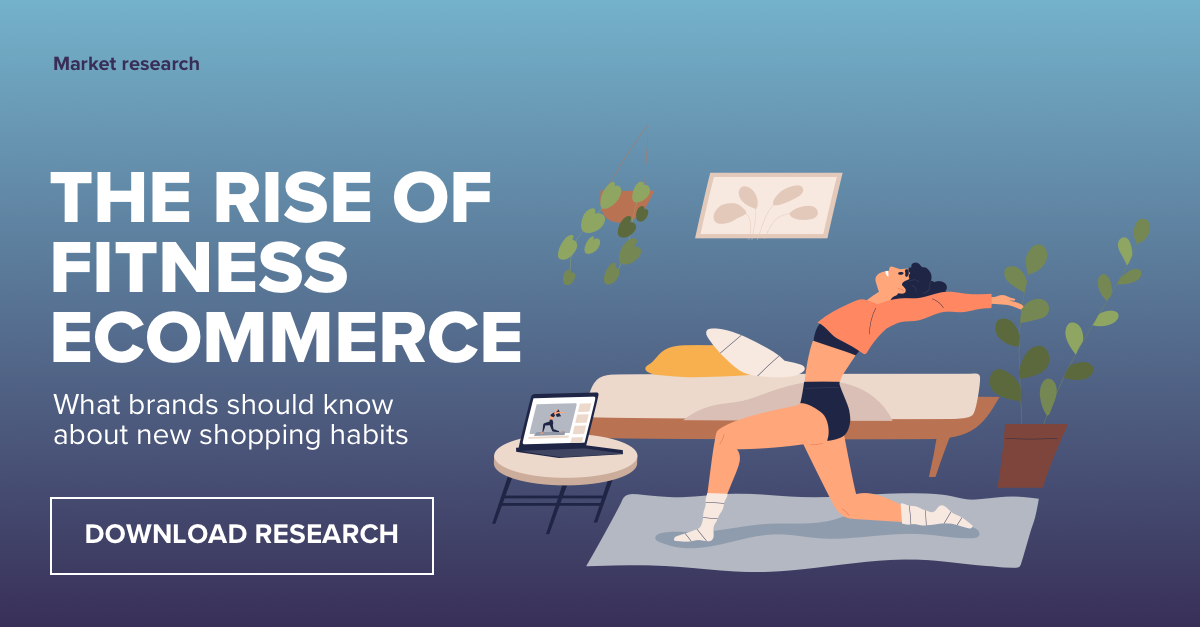In this article, we will take a look into Red Points’ market research on fake fitness products, as well as analyzing consumers’ new shopping habits and ecommerce trends.
The COVID-19 pandemic has affected people’s lives in many ways. Apart from the economic crash and drastic lifestyle changes, it has impacted our day-to-day habits too. As many gyms were closed during the quarantine and people were locked down at home, many started working out from home as an alternative.
A recent study from Mckinsey shows that 27% of U.S. citizens are increasing their exercising time at home. The online business for fitness products is booming as a result. Decathlon even stated that “Ecommerce has taken a massive lead in the last three months growing from a business share of 5% pre-COVID to 22-25% now.”
So it’s clear that the ecommerce boom in the fitness industry is here to stay. Red Points conducted research in August 2020 among 1,000 U.S. consumers who purchased fitness goods online in the past 3 months. In other words, consumers who shopped online since the start of the pandemic. The participants were also grouped by regions across the U.S., gender and age.
Summary:
- The rise of home gym leads to a boom in the fitness ecommerce industry
- Social media is becoming more prominent as an ecommerce channel
- Consumers care about product quality and therefore think brands should be responsible for it
Common fake fitness products to watch out for
Counterfeiting is bad for business; it defrauds customers and drains legitimate global economies of billions of dollars. It also results in an overabundance of substandard goods, some of which can be deadly.
Unlicensed and shoddily produced replicas of sporting goods are now just a click away thanks to the proliferation of third-party vendors on sites like Amazon, eBay, and Instagram.
Nike Air Jordans
Authorities frequently confiscate millions of dollars worth of counterfeit Nikes intended for online sales in the United States, making it the most widely counterfeited brand in the world. China is a common source of Nike knockoffs.
At the Los Angeles/Long Beach Seaport, US Customs and Border Protection personnel reportedly confiscated 14,806 fake Nike shoes in October 2019. More than $2 million would have been at stake if they were genuine.
The x Nike Blazer and the Nike Air VaporMax are also prevalent forgeries, but they’re not as common as the fabled Air Jordan line. As a result of global counterfeiting, the entire brand is at risk.
Yeezy Sneakers
Instagram’s more than one billion active users may now purchase products they see on Instagram without ever leaving the app thanks to the recent debut of Checkout on Instagram.
New secure-purchasing platforms, according to data analytics firm Ghost Data, have allowed counterfeiters, many of whom use strategies similar to those used by legitimate marketers, to flood the market with their knockoffs. Sneakers designed by Kanye West, known as the Yeezys, are among the most often copied goods.
Sports Memorabilia
The sports memorabilia market, now worth $750 million annually, is infested with con artists, in large part because sports fans are so gullible.
According to the FBI, 70 percent of all autographed sports memorabilia are fake. Forged autographs and bogus game balls and bootleg jerseys, among other artifacts, are still common on auction sites like eBay. It can be difficult to establish the authenticity of many of these items.
Sports Apparel
The most popular counterfeit soccer product is a cheap replica football jersey. Despite the fact that the costs of these products are substantially lower than for genuine goods, in recent years many of them have become high-quality fakes, which has increased their popularity due to their ability to “pass” as genuine. There are many people that buy cheap replica football jerseys and kits on the internet because they are confused about what they are getting themselves into.
Home gym is here to stay
Tutorial videos on Youtube, workout apps, and home gym equipment will always have a special place in the heart of many fitness enthusiasts. Due to the recent pandemic, many people who used to go to the gym were locked down at home, or stopped going. In the past couple of months, these people have also started working out from home.
In fact, our research shows that 50.65% of the participants are planning on working out from home during the rest of 2020. This will lead to a growing demand for fitness products, especially fitness equipment, since consumers will need to have them home, instead of going to the gym and sharing the equipment with others.
Consumers’ investments are thus influenced by their new workout routine: the average spend of people investing in fitness products has seen an increase of $265.68 since the start of the pandemic. Some participants (5%) have even spent more than $1,001 in fitness products.
Quality and affordability attract consumers the most
When asked what’s the most important factors when buying fitness equipment online, it’s no surprise that consumers value quality the most (53.6%), followed by affordability (48.5%) and design (44.7%). As for their go-to product categories, consumers have chosen fitness apparel & accessories (50.2%), workout devices (50%) and yoga and flexing accessories (49%).
Social media and influencers have a strong impact on the fitness industry
Consumers have access to many channels for new product discovery and search. Unlike many other industries, consumers tend to rely more on word of mouth when it comes to fitness products. If we take a look at the data, social media is the most used tool (60.3%) for consumers to conduct product research, followed by online influencers (50.4%) and marketplaces (42.4%). It’s been a pivoting year for online shopping. As many ecommerce platforms ramp up their efforts, many social media platforms have also facilitated brands to sell on their sites. Facebook recently introduced Facebook Shops, and Walmart has expanded its marketplace. It’s worth noting that consumers’ shopping habits have also evolved when it comes to where they are most likely to buy fitness products from. The majority of consumers chose to buy from traditional marketplaces like Amazon, eBay, etc (36%), while social media is taking the second place (29.1%), exceeding the brand’s official website at the third place (24.7%).
What’s concerning is that most shoppers rely on reviews to determine product authenticity (55%), and bad guys are even making business out of it: they often provide fake reviews on platforms like Amazon. This means that if your own product page has negative reviews, it’s very likely that it will sway buyers’ decision and not purchase from that page.
Consumers are blaming brands for letting fakes into the market
Counterfeiters are everywhere, however the counterfeit fitness industry is among one of the world’s most lucrative industries for bad actors. That’s worrying not only because letting fakes leak into the market can mean serious damage to brand reputation, but also there are many products that can harm consumers like fake climbing gear. Our research shows that about half of the consumers have bought fake fitness products, this comes as a big warning sign for the fitness brands selling online.
As mentioned before, the fitness industry scores a big market share on social media. On the other hand, our data also shows that social media is the channel where most of the counterfeits were purchased. So if a brand’s revenue relies heavily on social media, having counterfeiters on the same platform indicates that it’s very likely they are stealing sales from them.
Because the quality of counterfeit products can’t be compared with the original ones, and since quality is the number one factor that consumers care about, we can imagine the frustration when seeing the products they ordered aren’t performing. When asking about their reaction if they unknowingly bought a fake fitness product, the majority of respondents said that they would complain to the original brand (27%), others would write a bad review about the brand (25%) and ask for a refund (22%).
What’s next
Counterfeits can harm brands and consumers in numerous ways. Letting fake products enter the market unchallenged could mean serious damage to brand reputation, product uniqueness, revenue and IP efforts. Brands need to protect themselves from online infringements, whether they are sold from impersonated social media accounts, or counterfeiters’ sites. Red Points offers free brand audits to support your business at scale, and provide customized brand protection solutions to tackle the problems at the source.
To get more insights and pro-tips on how to stand out in the ecommerce boom, download Red Points’ Fitness equipment Market Research.






